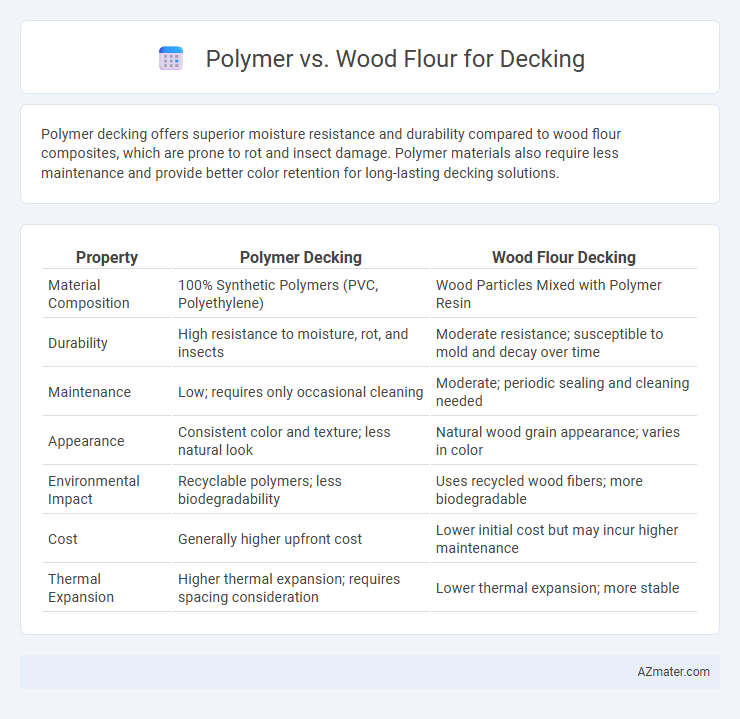Polymer decking offers superior moisture resistance and durability compared to wood flour composites, which are prone to rot and insect damage. Polymer materials also require less maintenance and provide better color retention for long-lasting decking solutions.
Table of Comparison
| Property | Polymer Decking | Wood Flour Decking |
|---|---|---|
| Material Composition | 100% Synthetic Polymers (PVC, Polyethylene) | Wood Particles Mixed with Polymer Resin |
| Durability | High resistance to moisture, rot, and insects | Moderate resistance; susceptible to mold and decay over time |
| Maintenance | Low; requires only occasional cleaning | Moderate; periodic sealing and cleaning needed |
| Appearance | Consistent color and texture; less natural look | Natural wood grain appearance; varies in color |
| Environmental Impact | Recyclable polymers; less biodegradability | Uses recycled wood fibers; more biodegradable |
| Cost | Generally higher upfront cost | Lower initial cost but may incur higher maintenance |
| Thermal Expansion | Higher thermal expansion; requires spacing consideration | Lower thermal expansion; more stable |
Introduction to Decking Materials
Polymer decking materials offer enhanced durability, resistance to moisture, insects, and rot compared to traditional wood flour composites, making them ideal for long-lasting outdoor applications. Wood flour-based decking blends natural wood fibers with plastic, providing a more affordable and eco-friendly option but often requires more maintenance due to potential fading and mold. Choosing between polymer and wood flour decking depends on factors such as budget, desired lifespan, and environmental exposure.
Overview of Polymer Decking
Polymer decking is made from high-performance synthetic materials combining recycled plastics and additives to enhance durability and weather resistance. Unlike wood flour, which is a natural wood fiber filler, polymer decking offers superior resistance to moisture, rot, and insect damage, making it ideal for outdoor environments. Its low maintenance requirements and long lifespan make polymer decking a popular choice for long-lasting, eco-friendly decking solutions.
Overview of Wood Flour Decking
Wood flour decking offers a natural aesthetic with the ability to blend seamlessly into outdoor environments, providing a traditional wood texture and appearance. Made from finely ground wood fibers, it is commonly used in composite decking materials, combining wood flour with plastic resins to enhance durability and resistance to moisture and insects. This type of decking requires regular maintenance to prevent rot and fading but remains a popular choice for its environmental benefits and cost-effectiveness compared to pure polymer options.
Comparative Durability: Polymer vs Wood Flour
Polymer decking exhibits superior durability compared to wood flour composites due to its enhanced resistance to moisture, rot, and insect damage, extending the lifespan by up to 25 years. Wood flour-based decking, while offering a more natural appearance, tends to absorb water, leading to swelling, cracking, and decay over time, which reduces its structural integrity. The polymer matrix in composite decking provides a stable, low-maintenance surface that withstands harsh weather conditions better than traditional wood flour components.
Moisture Resistance and Weather Performance
Polymer decking consistently outperforms wood flour composites in moisture resistance due to its non-porous structure, reducing risks of mold, rot, and swelling. Wood flour decking absorbs water more readily, leading to potential warping and surface degradation under prolonged exposure to rain and humidity. Superior weather performance of polymer materials includes enhanced UV resistance and color retention, ensuring longer-lasting durability in outdoor environments.
Maintenance Requirements
Polymer decking requires minimal maintenance, needing only periodic cleaning with soap and water to prevent dirt buildup and mold growth. Wood flour composites, while offering a similar wood-like appearance, demand more frequent sealing and occasional sanding to maintain their aesthetic and prevent moisture damage. Selecting polymer decking reduces time and costs associated with upkeep compared to wood flour alternatives.
Environmental Impact and Sustainability
Polymer decking materials are typically made from recycled plastics, reducing landfill waste and requiring less deforestation compared to wood flour composites, which rely on natural wood fibers. Wood flour decking incorporates organic fibers that are biodegradable but may contribute to deforestation and require chemical treatments for durability. Selecting polymer decking enhances long-term sustainability by offering greater resistance to moisture, pests, and decay, leading to less frequent replacement and reduced environmental disruption.
Cost Analysis: Upfront and Long-Term
Polymer decking typically has a higher upfront cost than wood flour decking due to advanced manufacturing processes and materials. Wood flour composite decking offers a lower initial price but may incur higher maintenance expenses over time, such as sealing, staining, or potential replacement. Long-term cost analysis favors polymer decking for durability and reduced maintenance, resulting in better value over the lifespan of the deck.
Aesthetic Appeal and Design Options
Polymer decking offers a consistent color palette and smooth finish, enabling sleek, modern aesthetics with minimal fading or staining over time. Wood flour composites provide a natural wood grain appearance and texture, appealing to traditional design preferences while allowing customization through staining or painting. Both materials support diverse decking styles, but polymer excels in vibrant color retention and low maintenance, whereas wood flour emphasizes authentic, rustic charm.
Best Applications and Recommendations
Polymer decking excels in moisture resistance and low maintenance, making it ideal for high-humidity environments and heavy foot traffic areas. Wood flour composite decking offers a more natural wood aesthetic and is suited for applications where environmental sustainability and affordable installation are priorities. For best performance, use polymer decking in commercial or coastal settings, while wood flour composites work well in residential decks with moderate exposure to weather.

Infographic: Polymer vs Wood flour for Decking
 azmater.com
azmater.com